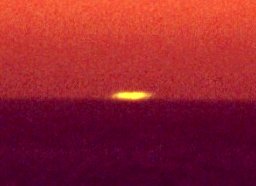

|
|
Green Flash shot from the coast of La Jolla (I have to admit that it's not the best shot. I hope for clear winter days to come ...)
|
The Green Flash is the result of (at least) three physical principles:
The blue color of the sky is one consequence of this fact. Another consequence is that the Sun becomes red when it goes down: when the Sun is close to the horizon its rays have to travel a longer way through the Earth's atmosphere. So the chance for a "light quantum" of getting scattered is greatly enhanced, in particular if the quantum is blue. When the Sun is low, most of the blue light is therefore filtered out and only green and red light remain in the Sun's rays.
"Refracted" means that the Sun's rays travel on a bended curve rather than on a straight line through the Earth's atmosphere. One effect of this bending is that the Sun appears higher above the horizon (or shifted towards the zenith) than it would be without the Earth's atmosphere. Another consequence is that the solar disk becomes a ellipse during sunset: rays originating from the lower rim of the Sun (these are rays that are closer to the horizon), have a longer way to go and become more bended than rays from the upper rim that travel a shorter distance. The lower part of the Sun's disk is therefore more shifted upwards than the upper part, or, phrased differently, the sphere of the Sun appears to be flattened.
The important point with respect to the Green Flash is, however, that refraction depends on the light's color. Blue light is refracted (or bended) slightly more than green light and green light is slightly refracted more than red light. Therefore the Sun's disk actually consists of a flattened red disk, with a green disk above it, and a blue disk on top.
The Green Flash is best viewed on clear days with no obstacles near the horizon. Winter days in San Diego provide ideal conditions. Check out the great Green Flash that was photographed by Andrew Young from Torrey Pines Park in January 1996!
More information about the phenomenon can be found here. The most stylish way to watch a Green Flash in San Diego is probably from the restaurant "Green Flash" in Mission Beach!